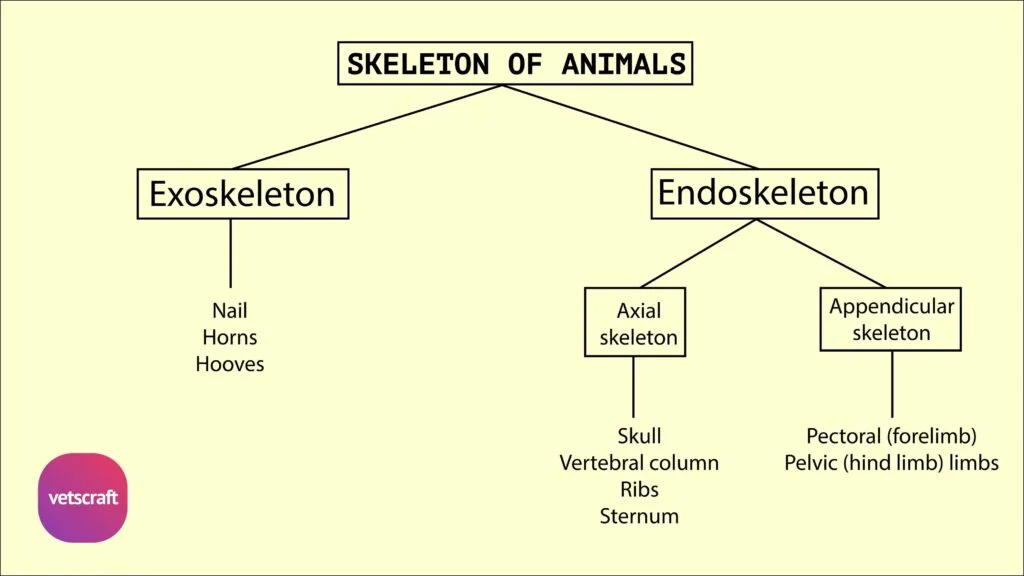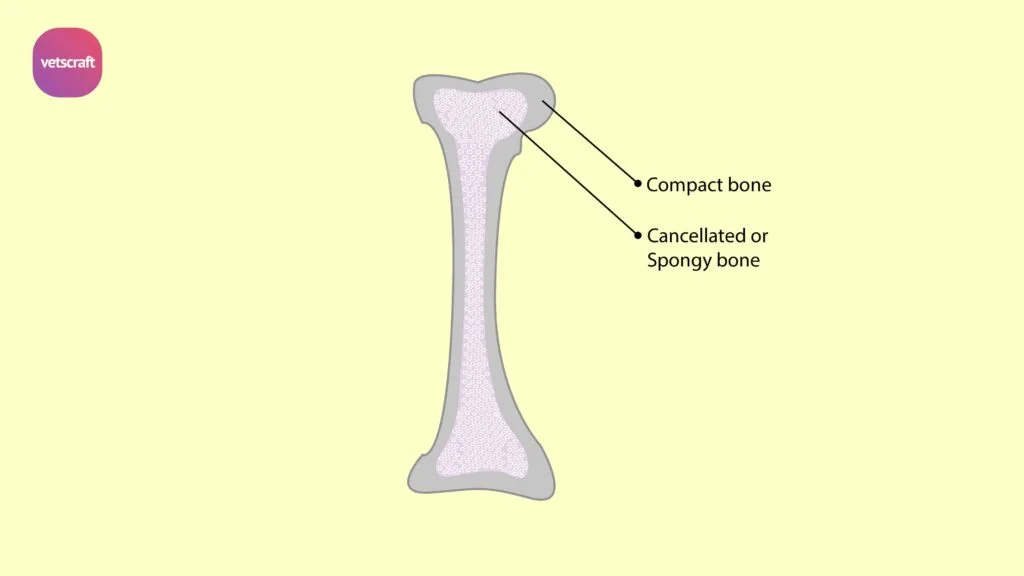TABLE OF CONTENTS
Vertebral Column in Domestic Animals: Structure of Typical Vertebrae and Vertebral Formula
The vertebral column in animals is the central axis of the skeleton, consisting of a series of interconnected bones called vertebrae. It provides structural support, protects the spinal cord, and enables movement and flexibility.
Certain vertebrae remain free throughout life and are termed movable or true vertebrae, and certain others fuse together with the adjacent ones and are termed fixed or false vertebrae.
The vertebral column as a whole may be divided, for description, into five regions—cervical, thoracic, lumbar, sacral, and coccygeal—according as they form the skeleton of the neck, back, loins, croup, and tail respectively.
The number of bones in each region, except the last, is fairly constant in each species, so that their number can be expressed as a formula called the vertebral formula.
| Domestic Animals | Cervical vertebrae | Thoracic vertebrae | Lumbar vertebrae | Sacral vertebrae | Coccygeal vertebrae |
|---|---|---|---|---|---|
| Ox | C-7 | T-13 | L-6 | S-5 | Cy-18-20 |
| Sheep | C-7 | T-13 | L-6-7 | S-4 | Cy-16-18 |
| Horse | C-7 | T-18 | L-6 | S-4 | Cy-15-21 |
| Pig | C-7 | T-14-15 | L-6-7 | S-4 | Cy-20-23 |
| Dog | C-7 | T-13 | L-3 | S-3 | Cy-20-23 |
| Rabbit | C-7 | T-12 | L-4 | S-4 | Cy-16 |
| Fowl | C-13-14 | T-7 | LS-14 | – | Cy-7 |
Typical Vertebrae
All the bones of the vertebral column that are constructed on the same general plan are termed typical vertebrae. Those that deviate from the general plan are called atypical vertebrae. The typical vertebra presents a body, an arch, and processes.

Body
- The body is the fundamental part of the vertebra around which the other parts are grouped.
- It is in the form of a solid rod.
- The anterior end is convex, and the posterior end is correspondingly concave.
- The anterior end of one vertebra meets the posterior end of the preceding vertebra, and between them is interposed a disc of fibrocartilage—the intervertebral disc.
- The dorsal surface of the body is flat and forms the floor of the vertebral foramen, while the ventral face presents centrally the ventral spinous process for muscular and ligamentous attachments.
Neural Arch
- The neural arch is situated on the superior face of the body, and it forms, with the body, a bony ring—the vertebral foramen.
- The entire series of these rings constitutes a canal called the spinal or vertebral canal for the lodgment of the spinal cord.
- Each half of the arch is made up of a vertical pedicle and a horizontal lamina.
- The anterior and posterior edges of the pedicles exhibit notches—the vertebral notches—which, when adjacent vertebrae are in position, circumscribe the intervertebral foramina for the passage of vessels and spinal nerves.
Processes
The processes of the vertebra are variable in size, development, and shape in the different regions. They are:
- Articular or Oblique Processes: These are four in number—two placed on the anterior and two on the posterior edge of the arch. These present articular areas, which face upward in the anterior and downward in the posterior processes. The anterior processes of one vertebra are overlapped by and articulate with the posterior processes of the vertebra in front and form synovial joints. The non-articular areas serve for muscular and ligamentous attachments.
- Transverse Processes: These are two in number for each vertebra, one on either side, springing from the lateral aspect of the body or the lower part of the arch. These vary in size and shape in the different regions.
- Spinous Processes (Neural or Superior Spines): These are single, projecting from the middle of the dorsal part of the neural arch. They vary greatly in size, form, and direction in different vertebrae.
- Ventral Spinous Processes: These are also single and are situated on the ventral aspect of the bodies of the vertebrae.
- Mamillary Processes: These are situated between the transverse and anterior articular processes or on the latter (e.g., lumbar vertebrae).
- Accessory Processes: These are situated between the transverse and posterior articular processes (e.g., lumbar vertebrae of the dog).

Vertebral Column as a Whole
Curve
- The curve of the column is slight and concave above in the cervical region, whereas in the dorsal and lumbar regions the curve is gently concave below, and in the sacral region it is strongly convex above.
- The curvature varies in the coccygeal region.
Vertebral (Neural) Canal
- The caliber is greatest in the atlas.
- It is reduced in the axis but becomes wider at the cervico-dorsal junction. From here, it is once again reduced up to about the terminal part of the dorsal region.
- It increases again in the lumbar region up to about the middle of the sacrum. It thereafter diminishes and disappears altogether by about the fifth or sixth coccygeal vertebra.
Processes
- The articular processes are best developed in the cervical region. They are smaller in the dorsal region but become larger and strongly curved in the lumbar region.
- The spines are best developed in the dorsal region. In the lumbar and sacral regions, they are shorter but plate-like. In the cervical region, they are shorter.
- The ventral spines are best developed in the cervical region.
- The transverse processes are large and plate-like in the lumbar region, thick and short in the dorsal region, but larger in the cervical region.

